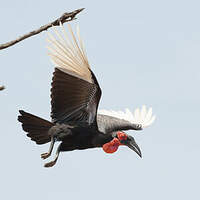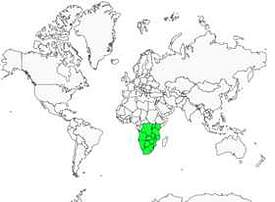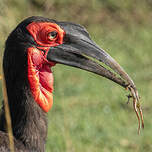Southern Ground Hornbill
Bucorvus leadbeateri - Bucorve du Sud
Identification
The Southern Ground Hornbill is a bird that, due to its size and weight, exceeds all other African and non-African hornbills. The two species of the Bucorvidae family (Southern Ground Hornbill and Abyssinian Ground Hornbill) are endemic to the African continent. However, their ranges are not the same, with the Abyssinian Ground Hornbill generally being found further north. It is a diurnal bird.
Outside of its white remiges, its plumage is completely black. Its face reveals a bright red skin devoid of feathers. The throat has a similar look, with its dilatable caruncles.
In the female, the jugular region also has a colored area with a violet-blue hue. In some cases, this pigmentation can extend to the lower parts of the face.
The male is larger and heavier than the female, weighing between 3.5 and 6.2 kilograms, compared to 2.2 to 4.6 kilograms for the female.
Its powerful and imposing curved beak, dark gray to black in color, appears heavy, but is actually hollow. A spongy bone tissue reinforces it. The protuberance at the base of the top, called a helmet, is more prominent in the male and variable in size according to the individual.
Its eyes, circled by long black eyelashes, are light gray-blue in color and have an unmistakeable gaze.
Its black tarsi are protected by thick scales. Its four fingers, strong and short, are ended by robust nails. The ground hornbill is syndactyl, with the outer finger fused to the middle one up to the third articulation.
Its wings are wide and powerful, and it has a long tail.
Juveniles have a darker brown plumage. The naked skin areas vary from light brown-gray to grayish-yellow depending on age and development. During the various evolution stages until sexual maturity (between 4 and 6 years) their appearance changes to become closer to that of an adult.To see the different stages: Here
They have black spots on the primaries.
The sides of the bill are a lighter gray than in an adult Southern Ground Hornbill.
Subspecific information monotypic species
Foreign names
- Bucorve du Sud,
- Cálao terrestre sureño,
- calau-gigante,
- Rotgesicht-Hornrabe,
- kaffer szarvasvarjú,
- Zuidelijke Hoornraaf,
- Bucorvo meridionale,
- sydlig hornkorp,
- Rødmaskehornravn,
- krkavčiak menší,
- zoborožec kaferský,
- Sydlig Hornravn,
- etelänkalkkunasarvekas,
- Bromvoël,
- calau terrestre meridional,
- dzioboróg kafryjski,
- Кафрский рогатый ворон,
- ミナミジサイチョウ,
- 红脸地犀鸟,
- sydlig hornkorp,
- 紅臉地犀鳥,
Voice song and call
The Southern Ground Hornbill emits a deep and resounding bellow. A sound close to ooomph ooomph-ooomph often repeated, most frequently early in the morning, in the evening or before rain. Listen to the song of the Southern Ground Hornbill in a video on the website Arkive.
The inflatable sacs on its neck are used to generate and amplify these sounds, said to resemble a lion's roar. They can be heard up to one kilometer away (Birds, A.H. Evans).
Habitat
Behaviour character trait
The Southern Ground Hornbill is a gregarious bird that lives in small groups of 2 to 8 individuals (rarely up to 12).
The rather complex organization of the clan is structured around the dominant male and female, who are the only ones to reproduce. This cohesion around the alpha couple is found in all their activities: the other adults (mostly males) and immatures (of both sexes) participate together in defending the territory, in feeding the female during the incubation period, as well as feeding the young.Essentially terrestrial, they occupy a vast territory of around 100 km2. They can walk several kilometres in search of food. Their very solemn gait, tinged with a certain pride, gives them a rather fascinating attitude to observe. The way they put their feet on the ground (fingers not resting completely) accentuates the proud aspect of their look. Most of the time they are in motion, never staying still for very long. They can run at a speed of about 30 km/h.
During the period of feeding the young, their way of collecting food is also singular. They pick up the different prey in their beak. If they find another one, they drop the first ones on the ground, kill the new prey, carefully rearrange everything before taking them all away with their beak, in order to bring them to the alpha female or to her young.
They go back to the trees to spend the night.
Like many birds they take dust baths.
Flight
In flight, the white flight feathers are very clear and characteristic. The beats are rather slow and powerful.
Preferring to walk, it only takes flight when disturbed or to perch in a tree. It does not hesitate however to launch into aerial chases in order to chase intruders out of its territory, or to reach recently burned areas in order to secure easy prey. It is sedentary and territorial. The only movements observed take place at maturity when the young disperse. These are mainly young females that join another group.The Southern Ground Hornbill flies well but, unlike other large birds, it does not rise much, staying at altitudes quite close to the ground.
Dietfeeding habits
The Southern Ground Hornbill feeds on the ground and is essentially carnivorous. Its diet consists of insects (grasshoppers, beetles), scorpions, termites, and when the opportunity is available, birds or eggs.
During the dry season, it also eats insect larvae, snails, frogs and toads.It also attacks larger prey, such as snakes, lizards, monitors, rats, young hares, squirrels, mongooses and turtles. You can see photos of a monitor predation on this site (the photos are clickable)
Although not the basis of its diet, it does not disdain seeds and other fruits.
If it finds a carcass, it will not hesitate to devour it. In fact, it feeds on anything that is within its reach and it can catch. The larger prey are chased, grabbed and dismembered by several members of the group.
Its powerful beak allows it to kill and shred its prey, but also to dig into the ground, excrement or decaying wood. (Video on the Arkive site.) When it finds something to eat, it throws it in the air, tilts its head back with its beak open so that the prey falls into its beak. As adults, they master this technique perfectly.
The Southern Ground Hornbill does not drink water, the supply of its food is enough.
Reproduction nesting
The breeding cycle usually occurs between September and December, usually after the first rains. The congregational behaviors of the Southern Ground Hornbill can also be seen during reproduction. In fact, the dominant couple is aided by the other members of the group, adults and juveniles, for feeding.
Unlike the hornbills, and like the Abyssinian Ground Hornbill, the dominant female is not walled up in the cavity where she will lay her eggs. The nest is placed in a hollow tree trunk (or in a rocky cavity on a cliff, such as in KwaZulu Natal), at a height of 2 to 5 meters.
The minimum diameter is 40 cm, which limits the number of potential sites.
The female usually lays two eggs (in about 80% of cases) whitish and slightly marbled with light brown. Sometimes only one is laid, and rarely three. The interval between laying is from 3 to 5 days. During incubation, which lasts 37 to 43 days, the dominant female will be fed in the nest by the other members of the group.
The first egg to hatch gives birth to a chick that will develop quite quickly. The difference in size and weight thus generated will not allow the second chick to compete with the elder. He will die of starvation after a week (rarely any longer). At hatching the chick has no feathers. Its naked skin is pink, then it becomes black about 3 days later. See a video taken in a nest at Arkive.
It will be fed at a rate of 4 to 9 daily meals. The different prey are brought in the bill.The female leaves the nest when the chick is about 4 weeks old. It will leave itself when it is approximately 86 days old, fully feathered. The juvenile remains with the parental group at least until maturity and depends on the adults until it is 6 months/1 year old. A study carried out in South Africa (Kruger National Park) shows that a family group produces only one fledging on average every 9.3 years. Elsewhere, particularly in the Okavango Delta in Botswana, breeding appears to be more frequent (approximately one successful breeding about every 2.6 years).
Sexual maturity occurs around the sixth year, but it is estimated that females are successful breeders at the age of 15-17 years old (Morrison 2005).
Geographic range
The Southern Ground Hornbill primarily lives in Southern Africa. It is found from south Kenya and Burundi, to the east and northeast of South Africa. It can also be observed in the south-western zone of Angola and in the north of Namibia. It can be fairly common in some areas, but mostly remains in protected zones.
Threats - protection
IUCN conservation status
concern
in the Wild
threatened
evaluated
Since 2010, the IUCN has listed the Southern Ground Hornbill in the vulnerable category. Its future status could worsen and move into the higher category (endangered). This species is now mainly confined to reserves and national parks. It seems that the decrease of its populations is not as rapid in Zambia than in other parts of its range.
The destruction of its habitat, and various persecutions are some of the main causes of this rapid decline. Poisoned baits, intended for predators and rabid animals, are also contributing to that decrease. Electrocutions, as well as the exotic bird trade, often to supply zoos, also have an impact.
Due to its unique behaviour, they are also targeted for direct shooting. Indeed, the Southern Ground Hornbill is very territorial and cannot stand the sight of an intruder. If it is confronted to its own reflection in a window, mistaking it for another bird, it may shatter it with a peck. What may seem anecdotal is actually far from being it, as this behaviour, usually typical of territorial males, has a real impact in some areas. More information on this behaviour can be found here and there.
The Southern Ground Hornbill is also used in traditional medicine, known as muti (traditional medicine based on plants, animals or wood).
A tribes belief attributes to it the power of favouring rain, for that purpose, some birds are killed during periods of drought.
On the other hand, the Masai consider that it must not be killed, otherwise misfortune would befall them; if a Southern Ground Hornbill lands on the roof of a house, they must leave because they consider that its presence is an omen of death for the occupants.Moreover, the species' breeding rate and pattern does not support a renewal of generations. Various study and protection programs have been put in place in South Africa:
- an artificial nesting program has been carried out to make up for the scarce suitable trees for nests. Here is an information page about this program.
- collecting the second chick in the nest before it dies has been attempted. They are fed and put in incubators in order to re-release them into the wild. Between 2000 and 2008, Mabula Project released 13 birds.
- studies on population dynamics have been done to understand the considerable differences in terms of births depending on the region.
- significant awareness-raisers are organized.
- identifying and preserving key habitats for the Southern Ground Hornbill.
Sources of information
- IOC World Bird List (v15.1), Gill, F and D Donsker (Eds). 2025-12-07.
- BirdLife International, BirdLife International
- ARKive, Christopher Parsons
- Wikipédia, Wikipedia, The Free Encyclopedia
- Mabula ground hornbill conservation project,
- Vol. 6 - Handbook of the Birds of the World, Josep del Hoyo-Andrew Elliott-Jordi Sargatal
- Birds of Southern Africa, Ian Sinclair, Phil Hockey, Warwick Tarboton
Other sources of interest
 Specification sheet created on
30/07/2023 by Yvonnik Lhomer
Specification sheet created on
30/07/2023 by Yvonnik LhomerTranslation by AI Oiseaux.net
© 1996-2025 Oiseaux.net
- Accipitriformes
- Aegotheliformes
- Anseriformes
- Apodiformes
- Apterygiformes
- Bucerotiformes
- Caprimulgiformes
- Cariamiformes
- Casuariiformes
- Charadriiformes
- Ciconiiformes
- Coliiformes
- Columbiformes
- Coraciiformes
- Cuculiformes
- Eurypygiformes
- Falconiformes
- Galliformes
- Gaviiformes
- Gruiformes
- Leptosomiformes
- Mesitornithiformes
- Musophagiformes
- Nyctibiiformes
- Opisthocomiformes
- Otidiformes
- Passeriformes
- Pelecaniformes
- Phaethontiformes
- Phoenicopteriformes
- Piciformes
- Podargiformes
- Podicipediformes
- Procellariiformes
- Psittaciformes
- Pterocliformes
- Rheiformes
- Sphenisciformes
- Steatornithiformes
- Strigiformes
- Struthioniformes
- Suliformes
- Tinamiformes
- Trogoniformes
































